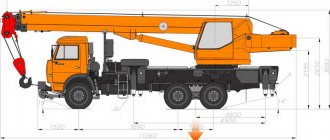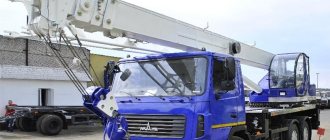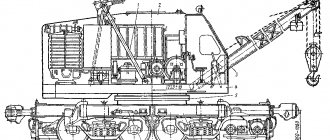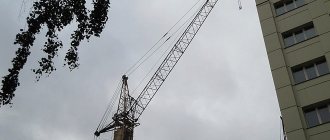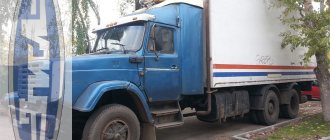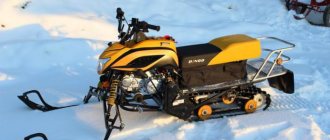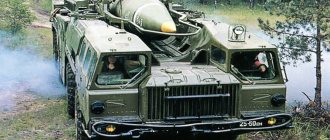The KS-4561 truck crane was developed at the design bureau of the Kamyshin plant. The chassis of a heavy KrAZ-257K1 or 250 truck, equipped with a rear bogie wheel drive, is used as the base. The machine is used for loading and unloading operations, as well as for driving piles. For this purpose, additional equipment is installed, including a diesel hammer.
Description
An 8-cylinder 240-horsepower YaMZ-238 diesel engine is used to drive the crane units. A transfer gearbox is installed on the chassis, on which the power take-off is located. The output shaft of the box is connected by a cardan shaft to an asynchronous alternating current generator with an operating voltage of 400 V. The power take-off is activated by a separate lever located in the driver's cab.
The generator allows you to connect consumers with a total power of up to 30 kW. The machine is equipped with an electrical distribution panel, which contains connectors for connecting external power.
An asynchronous motor with a power of 15 kW is used to drive the main winch. Changing the boom installation angle is carried out by a separate gearbox driven by a 7.5 kW motor.
Current is transmitted from the generator through a slip ring located inside the slewing support mechanism. Changing the engine speed is carried out by adjusting the frequency (within 37.5-50 Hz) and voltage (within the range 320-400V). The winch motor is equipped with a special device that generates a constant magnetic field. When the device is turned on, electromagnetic braking of the rotor occurs, which ensures a slow lowering of the load. The function is used for loads up to 6 tons.
Machine Specifications:
- crane length in transport position - 14000 mm;
- width - 2500 mm;
- height (with the boom folded) - 3800 mm;
- length of the support contour - 3370 mm;
- width of the support contour - 3860 mm;
- curb weight - 21.5 tons;
- load capacity - 16 tons;
- wheelbase - 5750 mm;
- turning radius (on the outer wheel) - 14 m;
- front/rear wheel track - 1950/1920 mm.
KS-4561
The KS-4561 truck crane (previously designated K-162) is equipped with a full-rotating working platform on which a 10 m long cargo boom is mounted. The unit has a parting line that allows the installation of additional 4 m long sections. The design of the tower installation allows you to increase the boom length to 22 m and install additional 5 meter jib. The vehicle was built only on the KrAZ-257K1 automobile chassis.
The crane allows you to work without installing additional outriggers; the load capacity with a 10 m boom is 4.4 tons. In this case, the vehicle can move at a speed of up to 5 km/h. The machine allows you to lift loads from holes up to 3 m deep. On public roads, the crane unit without a load can move at a speed of 65 km/h.
KS-4561A
The KS-4561A crane is a further development of the previous modification; early releases use the KrAZ-257K1 chassis as a base. When using a model 250 truck, the crane index changes to 4561A-1. The new chassis features an improved driver's cabin for increased strength and durability. The machines were supplied with a standard 10 m lattice boom.
The crane uses a modified generator with improved performance and cooling. The equipment allows work to be carried out in winds of up to 14 m/s (at a height of 10 m). The crane remains stable when the wind increases to 27 m/s, but moving loads is prohibited.
The driver's workplace and controls are located in a separate metal cabin mounted on a turntable. The windshield is equipped with a folding mechanism and an electric heater is installed. When transporting the crane by rail, the cabin is partially disassembled.
KS-4561AM
The vehicle is a modification created taking into account the requirements of the USSR Ministry of Defense. The crane was shipped to the customer painted in a protective color and passed army acceptance. The design difference from the civilian version is an additional electric motor to drive the auxiliary winch. The knot was used when installing an extension jib. The power of the electric motor is 7.5 kW.
Technical characteristics of the KS-4561 truck crane and its modifications
The KS-4561 truck crane was developed at the design bureau of the Kamyshin plant. The chassis of a heavy KrAZ-257K1 or 250 truck, equipped with a rear bogie wheel drive, is used as the base. The machine is used for loading and unloading operations, as well as for driving piles. For this purpose, additional equipment is installed, including a diesel hammer.
Prices and analogues
The production of the crane ceased in the early 90s due to the completion of production of the basic chassis at the KrAZ plant. There are no new or retired vehicles for sale. The cost of used copies starts from 300 thousand rubles. Analogues are SMK-14 or KS-4562 cranes, equipped with individual electric winch drives. Another competitor is the KS-4572 hydraulic machine, which has a lifting capacity of 16 tons. The 3-axle KamAZ chassis is used as a base.
- home
Old-timer. KS-4561A from Kherson Model: diecast_43
It's been a while since I posted anything here. And all because I was thinking about radically improving the quality of photographs. It became a shame! Colleagues continually delight me with excellent photographs, but what about me? It’s high time to get a normal background, start using a tripod, and master image processing programs... Alas, it turned out as always. Spontaneously. The sun came out for an hour in our village today, and I couldn’t miss this chance. I quickly pulled a chair onto the balcony, threw several sheets of paper on it, and, in the old fashioned way, hand-held, photographed the recently purchased typewriter. In general, don’t blame me. We bring to your attention yet another mediocre photo of an excellent model.
If anyone was expecting exciting stories related to its creation or purchase, then I have to disappoint you - there were none. The model was purchased a month ago through a forum, from a collector from a small Ural town. To avoid sending a fragile item by mail, a cunning logistics scheme was developed. The seller kindly delivered it to Yekaterinburg and gave it to my friend, and he gave it to my colleague who went there on a business trip. The colleague, of course, received detailed instructions from me on how to handle the parcel. However, when it fell into my hands, I realized that there was no particular need for this: the box was all covered with menacing warning signs, including very funny ones, like “Don’t breathe!!!” In a word, everything went well, and the car reached its destination safe and sound.
At this point it is worth making a short excursion into the history of my hobby. Several years ago I ran into a problem. Collecting models of domestic racing cars, I pretty soon got hold of probably 80% of everything that was produced on this topic industrially (mainly thanks to DiP) and small-scale (through the efforts of Ukrainian workshops). All that remained were mega-rarities, for which they asked for absolutely inhumane money (such as the Samara T3 from Aversa), and the creations of single masters, often made in a single copy. However, such models are almost never found on sale, and the number of craftsmen who are passionate about this topic can be counted on the fingers of one hand. It is not surprising that the collection began to be replenished less and less often. But the fuse remained!
But then I came across models with so-called “traces of use”, simulating aging and dirt. They amazed me with their realism and excellent portrayal of the image! And thus my hobby received a new impetus! Over time, I discovered SarLab, TrEx, UMI and ModelStroy - the most famous workshops working in this genre. Their assortment miraculously coincided with what I wanted to see on my shelves: Soviet construction, road and agricultural equipment from the 50s-70s. Real hard working machines! I personally saw some of them on roads and construction sites in my childhood, some of them were remembered from Lev Shugurov’s three-volume book with stunning drawings by Alexander Zakharov (as Autoreview columnist Andrei Khrisanfov put it, “any garbage truck from him asks for a box of chocolates”). Later technology from the 80s and 90s seems to me much poorer in terms of aesthetics: all straight lines and box-shaped shapes, although I selectively take both it and pre-war cars.
Delving deeper into a new direction, I became convinced that the attitude towards artistic pollution among collectors is rather ambiguous. Some people believe that weathering helps hide paint defects, and there is some truth in this - on a clean model, any little detail is noticeable, but on a dirty one it is easy to disguise it. Others want to have models on the shelf “as if from an assembly line,” and I also agree with them if we are talking, for example, about government limousines or exhibition pieces. But if we are talking about real hard workers (trucks, tractors, rollers, excavators, cranes ), then I personally find it more pleasant to see them in a life-worn state. But only slightly, since there is also such a variety as “ghosts,” that is, dead equipment (throughly rusted, with broken windows, flat tires, etc.). This is not mine, although there are several similar works in the collection. Also, models with traces of use do not need to be wiped off from dust, which is a huge advantage for a lazy person like me! )))
At first, I didn’t understand this whole kitchen very well and, “out of hunger,” I rushed at all the “crazy guys” in a row. But I gradually realized that not all masters have the necessary talents; some simply decided to quickly make money on a fashion trend. Meanwhile, weathering is a real art, and it’s not at all easy to “fit” a model correctly. You need to know which elements are more susceptible to rust, how dirt is distributed throughout the chassis and body, be able to choose the right pigments and washes, and not overdo it with them. In addition, there is such a thing as artistic taste - some people have it, but others, alas, do not.
The author of this conversion is definitely in order with taste. True, if I myself had ordered this model from a master, I would have asked him to make it not so shabby. Seriously, some light touches would have been enough. Here there is a balancing act on the verge of overkill: it doesn’t seem like you can classify it as a “ghost” yet, but judging by the missing license plates, the car has already been written off and left to live out its life under a fence. But still, I really like the result, otherwise I would not have bought this faucet.
As for the base model, it is the KS-4561A on the KrAZ-257 chassis from the Ukrainian handicraftsmen Kherson Model. The shape of the cabin turned out to be successful and recognizable. And thanks to the use of the galvanoplasty method, it amazingly combines delicacy and strength. The superstructure also seems to be copper, the boom is soldered. The frame is made of resin, but since the model is unusually light for its size, you don’t have to worry about its integrity. It should be noted that the crane is static: the turntable is fixed, the boom has only a small vertical play, and the supports do not extend. But in my eyes, this doesn’t make it any worse. The not-so-successful original wheels were replaced with Kharkov ones, and the tires were also made by them. Plus, the master added a swing bridge, which brought the model to life even more.
There was already such a faucet in its pure form in the sandbox, although it was quite a long time ago - as much as 4 years ago. I highly recommend brushing up on that post! Especially the title photo is soulful, and my colleague solmi74 shows the details wonderfully. With my universal 15-85 mm lens, I’m not very good at macro photography, so here it’s mostly general plans. But I hope I managed to convey the charm of this model. At least I tried.
diecast-43.livejournal.com
Operating Parameters
The YaMZ-238M2 engine is a V-shaped diesel power unit consisting of 8 cylinders. The power of the element in question is 176 kW (240 hp) at 2,100 rpm.
A low-pressure pump with a fuel pumping function, a fuel injection advance clutch and an all-mode frequency regulator are options specific to this engine.
The power plant was also equipped with a dry air filter equipped with a clogging indicator and a pre-heater with a heat output of 32,000 kcal/h.
The design of the machine provides for a dry double-disc clutch. The gearbox is a mechanical type - three-way, five-speed.
The presence of a transfer case with two stages of operation and a center differential with the ability to block significantly increases the speed potential of the machine.
The 6x4 wheel arrangement, which ensures excellent vehicle maneuverability even in off-road conditions, implies in this case the use of radial tires.
The front suspension of the car is mounted on 2 semi-elliptical springs equipped with shock absorption.
The rear axle here is of the balancing type with sliding ends of the springs.
The functioning of the truck's braking system is ensured by drum mechanisms and a dual-circuit pneumatic drive operating on all wheels.
The first circuit of the separate drive ensures the operation of the brakes of the front and intermediate axles, the second - the rear. The presence of a spare and parking brake mechanisms guarantees even greater reliability of the KrAZ-250 and improves its technical characteristics.
The presence in the described system of such elements as a moisture separator and an alcohol-type fuse against condensate freezing optimizes the operation of this functional unit.


